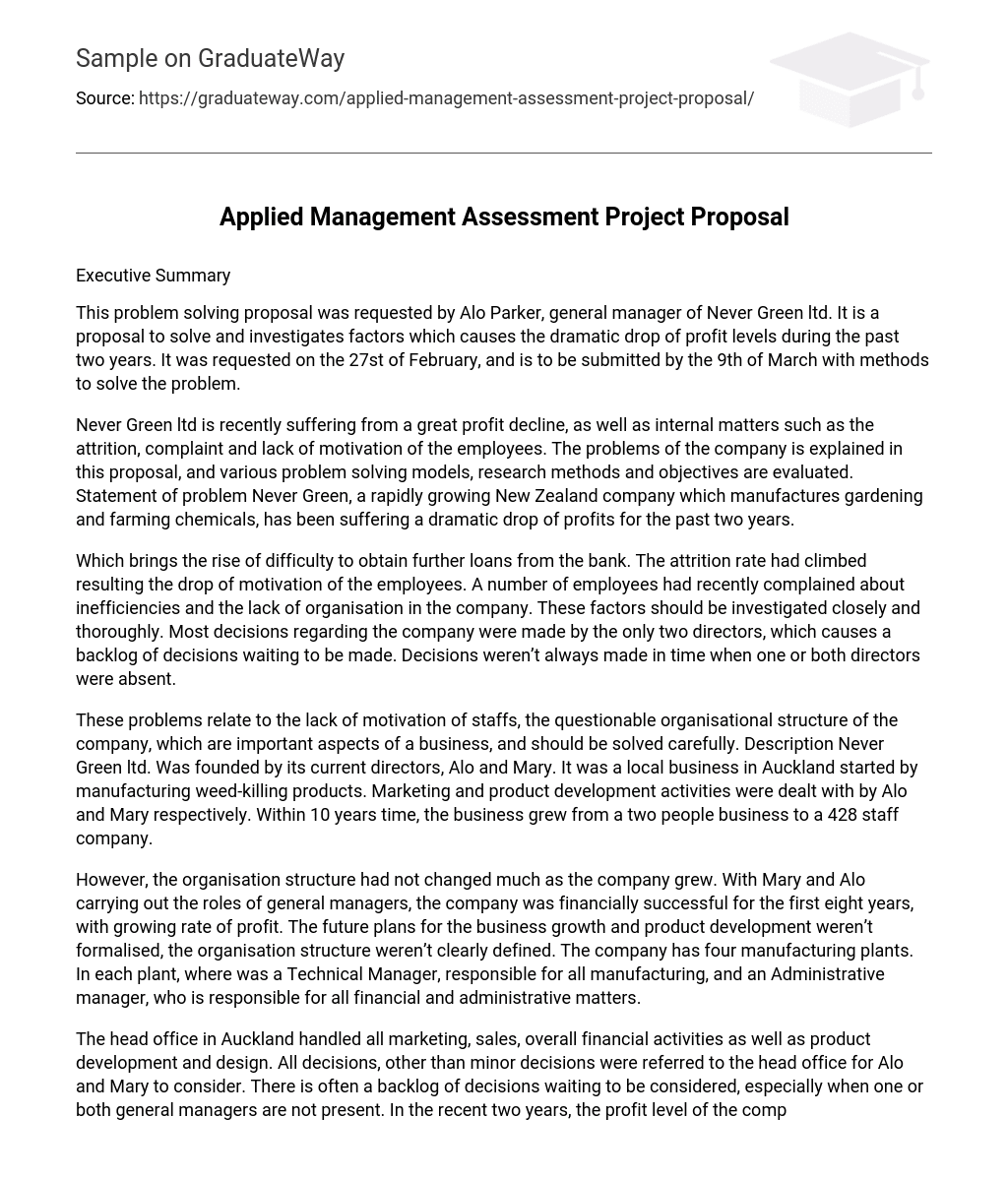Executive Summary
Alo Parker, the general manager of Never Green Ltd, has asked for a problem-solving proposal. The objective is to analyze the factors responsible for a significant decrease in profits during the past two years. The request was made on February 27th and must be submitted by March 9th, along with suggested strategies to address the issue.
The purpose of this proposal is to address the significant decline in profits, as well as internal obstacles such as employee attrition, complaints, and lack of motivation that Never Green Ltd is currently experiencing. This will be done through exploring various problem-solving models, research methods, and objectives.
Statement of Problem:
Never Green, an expanding New Zealand-based company, specializes in manufacturing gardening and farming chemicals. Regrettably, the company has experienced a substantial decrease in profits in recent years.
The bank is encountering difficulties in approving additional loans, resulting in increased attrition rates. Consequently, employee motivation has declined and there have been recent complaints regarding the company’s inefficiencies and disorganization. Hence, it is crucial to thoroughly examine these factors.
The company is facing a backlog of pending decisions due to the fact that only two directors are responsible for making the majority of decisions. When one or both directors are not present, there is often a delay in making these decisions.
Both the lack of motivation among staff and the questionable organizational structure of the company are significant issues that need to be carefully addressed in any business.
Never Green Ltd., established by its current directors Alo and Mary, began as a local business situated in Auckland. Its primary focus was the manufacturing of weed-killing products. Alo managed the marketing department, while Mary concentrated on product development. Remarkably, within a span of a decade, the company underwent significant growth, expanding its workforce from a mere two individuals to an impressive staff of 428.
Despite the company’s growth, the organizational structure remained largely unchanged. Mary and Alo served as general managers and enjoyed financial success for the first eight years, achieving a steady increase in profits. However, plans for future business expansion and product development lacked formality, and the organizational structure was poorly defined. The company currently operates four manufacturing plants, each overseen by a Technical Manager responsible for manufacturing operations and an Administrative Manager responsible for financial and administrative affairs.
The main office in Auckland is in charge of overseeing marketing, sales, finance, product development, and design. Alo and Mary, who are located at the head office, have the responsibility of evaluating and deciding on most issues except for minor ones. There is often a backlog of pending decisions to address, especially when one or both of the general managers are unavailable. In the last two years, there has been a noticeable decrease in profits for the company. Although the business still makes money, banks have started expressing worry about outstanding loans and overdrafts.
Despite the majority of employees remaining loyal to the company, there have been some complaints regarding inefficiencies and lack of organization. To tackle these concerns, it is important to utilize a variety of research methods to investigate the problems and develop solutions that will help accomplish the following objectives:
- To investigate the cause of the dropping profit in the business over the last two years and eliminate it to increase profits.
- To improve productivity and motivation by reducing friction between employees based on social factors.
- To find a solution to improve efficiency in the decision-making process.
- To increase profit levels by implementing cost-effective policies.
The topic of the research is “Research Methods.”
Seeking solutions for the best organizational structure to implement can be accomplished through interviewing managerial experts. Never Green has not tried implementing another organizing structure since the company’s inception, resulting in a limited understanding of the potential benefits or drawbacks of alternative systems. Therefore, it is advisable to consult with experienced managers as part of the research process.
Asking the right questions during an interview is essential and plays a vital role in various scenarios, such as working alone or leading/participating in a team (Adair,2010, p48). Conducting surveys among employees to identify the reasons for attrition can be an economical approach to address and eliminate this problem. To effectively solve the issue of employee attrition, it is crucial to comprehend the how and why behind it. By surveying employees at Never Green Ltd using relevant inquiries, managers can obtain valuable insights into the internal dynamics of their staff.
When looking to enhance profit margin, it is crucial that managers undertake research and gather information from reliable sources authored by trustworthy individuals. Such efforts will assist in identifying possible organizational structures that can be implemented at Never Green Ltd.
In order to effectively deal with issues, it is important to conduct a SWOT analysis which helps in identifying the strengths, weaknesses, opportunities, and threats of a business. Once problem areas are identified, it becomes crucial to analyze the timing, location, people involved, and reasons behind what occurred. Additionally, considering political influences and economic trends is essential for determining the underlying cause of the problem.
To move forward, the next step is to generate potential solutions using techniques such as brainstorming, fishbone diagrams, and mind mapping. It is important to perform this stage accurately because it allows for the emergence of multiple solutions. It should be noted that business problems are not conclusive; typically, there is not just one solution but several viable ones (van Aken & Berends, 2007). Afterward, these potential solutions can be evaluated using categorization, elimination, and ranking models.
This document provides a comprehensive evaluation of the main problem-solving alternatives, focusing especially on issues associated with implementation. To effectively address these concerns, it is recommended to utilize the “what if scenarios” model.
References
- Adair, J. (2010). Decision Making and Problem Solving Strategies. London: Koganpage.
- Aken, V., Ernst, J., & Berends, Hans. (2007). Problem Solving in Organizations: A Methodological Handbook for Business Students. Cambridge University Press.





